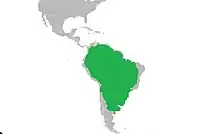Anaconda
Anacondas or water boas are a group of large snakes of the genus Eunectes. They are found in tropical South America. Four species are currently recognized.
| Anaconda Temporal range: Miocene-recent[1] | |
|---|---|
 | |
| Green anaconda, Eunectes murinus | |
| Scientific classification | |
| Domain: | Eukaryota |
| Kingdom: | Animalia |
| Phylum: | Chordata |
| Class: | Reptilia |
| Order: | Squamata |
| Suborder: | Serpentes |
| Family: | Boidae |
| Subfamily: | Boinae |
| Genus: | Eunectes Wagler, 1830 |
 | |
| Range of Eunectes | |
| Synonyms | |
| |
Description
Although the name applies to a group of snakes, it is often used to refer only to one species, in particular, the common or green anaconda (Eunectes murinus), which is the largest snake in the world by weight, and the second longest after the reticulated python.
Etymology
The South American names anacauchoa and anacaona were suggested in an account by Peter Martyr d'Anghiera, but the idea of a South American origin was questioned by Henry Walter Bates who, in his travels in South America, failed to find any similar name in use. The word anaconda is derived from the name of a snake from Ceylon (Sri Lanka) that John Ray described in Latin in his Synopsis Methodica Animalium (1693) as serpens indicus bubalinus anacandaia zeylonibus, ides bubalorum aliorumque jumentorum membra conterens.[2] Ray used a catalogue of snakes from the Leyden museum supplied by Dr. Tancred Robinson, but the description of its habit was based on Andreas Cleyer who in 1684 described a gigantic snake that crushed large animals by coiling around their bodies and crushing their bones.[3] Henry Yule in his Hobson-Jobson notes that the word became more popular due to a piece of fiction published in 1768 in the Scots Magazine by a certain R. Edwin. Edwin that described a 'tiger' being crushed to death by an anaconda, when there actually never were any tigers in Sri Lanka.[lower-alpha 1] Yule and Frank Wall noted that the snake was in fact a python and suggested a Tamil origin anai-kondra meaning elephant killer.[5] A Sinhalese origin was also suggested by Donald Ferguson who pointed out that the word Henakandaya (hena lightning/large and kanda stem/trunk) was used in Sri Lanka for the small whip snake (Ahaetulla pulverulenta)[6] and somehow got misapplied to the python before myths were created.[7][8][9]
The name commonly used for the anaconda in Brazil is sucuri, sucuriju or sucuriuba.[10]


Species and other uses of the term "anaconda"
The term "anaconda" has been used to refer to:

- Any member of the genus Eunectes, a group of large, aquatic snakes found in South America:
- Eunectes murinus, the green anaconda – the largest species, found east of the Andes in Colombia, Venezuela, the Guianas, Ecuador, Peru, Bolivia, Brazil and Trinidad and Tobago
- Eunectes notaeus, the yellow anaconda – a small species, found in eastern Bolivia, southern Brazil, Paraguay, and northeastern Argentina
- Eunectes deschauenseei, the darkly-spotted anaconda – a rare species, found in northeastern Brazil and coastal French Guiana
- Eunectes beniensis, the Bolivian anaconda – the most recently defined species, found in the Departments of Beni and Pando in Bolivia
- The term was previously applied imprecisely, indicating any large snake that constricts its prey,[11] though this usage is now archaic.
- "Anaconda" is also used as a metaphor for an action aimed at constricting and suffocating an opponent – for example, the Anaconda Plan proposed at the beginning of the American Civil War, in which the Union Army was to effectively "suffocate" the Confederacy. Another example is the anaconda choke in the martial art Brazilian jiu-jitsu, which is performed by wrapping your arms under the opponent's neck and through the armpit, and grasping the biceps of the opposing arm, when caught in this move, you will lose consciousness if you do not tap out.
See also
- Jaguar, a competitor or predator
Notes
- In South Asian languages like Hindi, the leopard and tiger may share the same name, that is Bágh (Hindi: बाघ), and it is the former that occurs in Sri Lanka.[4]
References
- Hsiou, Annie S.; Albino, Adriana M. (1 December 2009). "Presence of the Genus Eunectes (Serpentes, Boidae) in the Neogene of Southwestern Amazonia, Brazil". Journal of Herpetology. 43 (4): 612–619. doi:10.1670/08-295.1. S2CID 55097666.
- Ray, John (1693). Synopsis methodica animalium quadrupedum et serpentini generis (in Latin). London: Impensis S. Smith & B. Walford. p. 332. doi:10.5962/bhl.title.41459 – via Biodiversity Heritage Library.
- Owen, Charles (1742). An essay towards a natural history of serpents. London. p. 114. doi:10.5962/bhl.title.58688 – via Biodiversity Heritage Library.
- Pocock, Reginald I. (1930). "The Panthers and Ounces of Asia". Journal of the Bombay Natural History Society. 34 (2): 307–336 – via Biodiversity Heritage Library.
- Wall, Frank (1921). Ophidia Taprobanica or the Snakes of Ceylon. Ceylon: H. R. Cottle, Government Printer. p. 48. doi:10.5962/bhl.title.53694 – via Biodiversity Heritage Library.
- Willey, Arthur (1904). "Some rare snakes of Ceylon". Spolia Zeylanica. 1 (3): 81–89 – via Internet Archive.
- Ferguson, Donald (1897). "The derivation of "Anaconda"". Notes and Queries. 12 (294): 123–124. doi:10.1093/nq/s8-XII.294.123 – via Internet Archive.
- Skeat, Walter W. (1882). A concise etymological dictionary of the English Language. Oxford University Press. p. 16 – via Internet Archive.
- Yule, Henry; Burnell, Arthur C. (1903). Hobson-Jobson. London: John Murray. pp. 24–25 – via Internet Archive.
- "Dicionário online de português: sucuriju" (in Portuguese). Retrieved 19 February 2014.
- Simpson, J. A.; Weiner, E. S. C., eds. (1991). The Compact Oxford English Dictionary (2 ed.). Oxford: Oxford University Press. ISBN 0-19-861258-3.